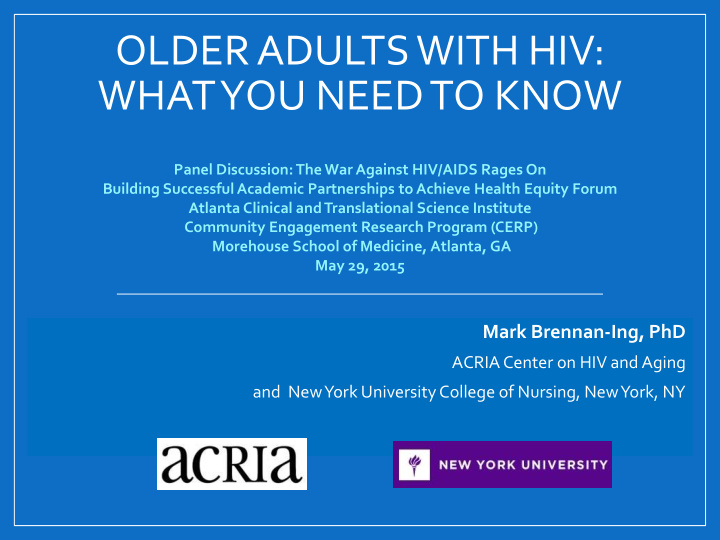



OLDER ADULTS WITH HIV: WHAT YOU NEED TO KNOW Panel Discussion: The War Against HIV/AIDS Rages On Building Successful Academic Partnerships to Achieve Health Equity Forum Atlanta Clinical and Translational Science Institute Community Engagement Research Program (CERP) Morehouse School of Medicine, Atlanta, GA May 29, 2015 Mark Brennan-Ing, PhD ACRIA Center on HIV and Aging and New York University College of Nursing, New York, NY
Background • Due to successful anti- retroviral therapies, adults 50 and older will account for the majority of people living with HIV in the U.S. by 2015. 1 • However, part of this growth is new infections, with adults 50+ accounting for approximately 11% of all new HIV infections 2 1 United States Senate Special Committee on Aging. HIV over Fifty: Exploring the New Threat. [Web cast]. May 12, 2005. Available at http://aging.senate.gov/hearing_detail.cfm?id=270655&. 2 Brooks et al. (2012). (Am J Public Health. Published online ahead of print June 14, 2012: e1 – e11. doi:10.2105/AJPH. 2012.300844.
The HIV population is graying; adults 50 and older will comprise over half of those living with HIV by 2015 (CDC, 2013).
% of All People with HIV in the US by Age Group: 2008-2010 CDC Surveillance Data 40% 35% 2008 2009 2010 30% 25% 20% 15% 10% 5% 0% <13 13 – 14 15 – 19 20 – 24 25 – 29 30 – 34 35 – 39 40 – 44 45 – 49 50+
Impact of Highly Active Anti-Retroviral Therapy (haart) 9 8 7 6 Mortality 5 (x 1000) 4 3 2 PWHA 1 (x 10,000) 0 81 82 83 84 85 86 87 88 89 90 91 92 93 94 95 96 97 98 99 00 01 02 HAART Source: NYC Dept of Health & Mental Hygiene, 2004
A National Trend 40 % and more 30-39 % 20-29 % 19 % and less % of People with HIV Age 50 and Older 2009-2010
Aging with HIV/AIDS in Atlanta Metro: Cases 50 and older 30000 26020 25000 20000 15000 8849 10000 5000 34% 0 All Cases Age 50+
Estimates of Life Expectancy on HAART: Below but Close to Normal CD4 Cell Count (mm 3) At HAART Initiation <100 100-199 >200 A 20 yr old will live to (years) 52 62 70 % Remaining Life Lost (all ages) 46% 27% 14% Adapted from ART-CC, Lancet 2008;372:293-99 – Slide Courtesy of A. Justice
The Complications of Success >50% of Deaths Attributed to Non-AIDS Events Adapted from ART-CC, Lancet 2008;372:293-99 – Slide Courtesy of A. Justice
R esearch on O lder A dults with H IV Purpose: Establish empirically valid normative data describing the growing and changing population of older adults with HIV 1000 NYC HIV adults 50 and older Participants completed self administered survey after giving consent
Comorbidities in ROAH HIV/STI-related Age-related Mental/Neuro/Other
Comparison of Number of Comorbidities in ROAH vs. National Health and Nutrition Examination Survey 2005 6+ 5 4 3 2 0-1 0 10 20 30 40 50 60 NHANES ROAH
CES-D Symptoms of Depression Moderate (16-22) 20% Severe (23+) 43% Not Depressed (1 to 15) 37%
Loneliness in ROAH vs. Others
ROAH: Social Networks 41.2 Parent 27.2 54 Child 37.7 78.7 Sibling 43.8 50.4 Other Relative 31.4 69.4 Friend 66.1 0 20 40 60 80 Living Functional A functional network member is someone in at least weekly phone/monthly in-person contact and can be reasonably assumed to provide assistance in times of need (Cantor & Brennan, 2000)
ROAH: Help Received Domain Type Family Friends Instrumental Shop/Run Errands 37.8 37.1 Keep House/Prepare Meals 32.3 23.6 Take/Drive Places 30.0 31.6 Mail/Correspondence 26.9 18.1 Manage Money/Pay Bills 23.7 16.5 Emotional Advice on Big Decisions 48.3 54.4 Talk to When Feeling Low 62.5 68.2 Talk About Personal Matters 59.0 64.9 Negative Reluctant to Talk 32.6 29.7 Made Upset/Hurt Feelings 35.7 33.7 Refused to Help 20.6 20.6
Implications of Assistance Patterns • Families typically provide the bulk of hand-on assistance compared with friends, but this is less evident among older PWHA • As typically observed, friends provide greater levels of emotional support, but support from friends has not compensated for absent family support • Thus, in line with the Hierarchical Compensatory Model, older adults with HIV frequently turn to government and community- based services for their needs
Hierarchical Compensatory Model Formal Services Cantor’s (1978) Hierarchical Compensatory Theory of Friends & Neighbors Social Support posits that we turn first for help to those closest in our Distant networks (spouse/partners Family & children), then to more distant relatives, friends, neighbors, and lastly to government and Close community-based Family organizations in a hierarchical manner
The Question? Are AIDS Service Organizations, Senior Service Providers and Government Agencies Prepared to meet the needs of a population growing older with HIV?
Thank You! For further information please contact: Mark Brennan-Ing, PhD Director for Research and Evaluation ACRIA: Center on HIV and Aging 575 Eighth Avenue, Suite 502 New York, NY 10018 (212) 924-3934 ext 131 mbrennan@acria.org www.acria.org 20
Recommend
More recommend